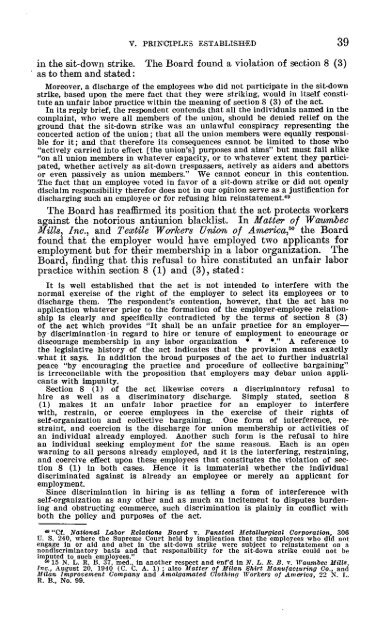NATIONAL LAB RELATIONS BOARD - National Labor Relations ...
NATIONAL LAB RELATIONS BOARD - National Labor Relations ...
NATIONAL LAB RELATIONS BOARD - National Labor Relations ...
Create successful ePaper yourself
Turn your PDF publications into a flip-book with our unique Google optimized e-Paper software.
V. PRINCIPLES ESTABLISHED 39in the sit-down strike. The Board found a violation of section 8 (3)as to them and statedMoreover, a discharge of the employees who did not participate in the sit-downstrike, based upon the mere fact that they were striking, would in itself constitutean unfair labor practice within the meaning of section 8 (3) of the act.In its reply brief, the respondent contends that all the individuals named in thecomplaint, who were all members of the union, should be denied relief on theground that the sit-down strike was an unlawful conspiracy representing theconcerted action of the union ; that all the union members were equally responsiblefor it; and that therefore its consequences cannot be limited to those who"actively carried into effect [the union's] purposes and aims" but must fall alike"on all union members in whatever capacity, or to whatever extent they participated,whether actively as sit-down trespassers, actively as aiders and abettorsor even passively as union members." We cannot concur in this contention.The fact that an employee voted in favor of a sit-down strike or did not openlydisclaim responsibility therefor does not in our opinion serve as a justification fordischarging such an employee or for refusing him reinstatement.49The Board has reaffirmed its position that the act protects workersagainst the notorious antiunion blacklist. In Hatter of WavombeeMills, Inc., and Textile Workers Union, of America, 5° the Boardfound that the employer would have employed two applicants foremployment but for their membership in a labor organization. TheBoard, finding that this refusal to hire constituted an unfair laborpractice within section 8 (1) and (3), stated :It is well established that the act is not intended to interfere with thenormal exercise of the right of the employer to select its employees or todischarge them. The respondent's contention, however, that the act has noapplication whatever prior to the formation of the employer-employee relationshipis clearly and specifically contradicted by the terms of section 8 (3)of the act which provides "It shall be an unfair practice for an employer—by discrimination • in regard to hire or tenure of employment to encourage ordiscourage membership in any labor organization * *." A reference tothe legislative history of the act indicates that the provision means exactlywhat it says. In addition the broad purposes of the act to further industrialpeace "by encouraging the practice and procedure of collective bargaining"Is irreconcilable with the proposition that employers may debar union applicantswith impunity.Section 8 (1) of the act likewise covers a discriminatory refusal tohire as well as a discriminatory discharge. Simply stated, section 8(1) makes it an unfair labor practice for an employer to interferewith, restrain, or coerce employees in the exercise of their rights ofself-organization and collective bargaining. One form of interference, restraint,and coercion is the discharge for union membership or activities ofan individual already employed. Another such form is the refusal to hirean individual seeking employment for the same reasons. Each is an openwarning to all persons already employed, and it is the interfering, restraining,and coercive effect upon these employees that constitutes the violation of section8 (1) in both cases. Hence it is immaterial whether the individualdiscriminated against is already an employee or merely an applicant foremployment.Since discrimination in hiring is as telling a form of interference withself-organization as any other and as much an incitement to disputes burdeningand obstructing commerce, such discrimination is plainly in conflict withboth the policy and purposes of the act.49 "Cf. <strong>National</strong> <strong>Labor</strong> <strong>Relations</strong> Board v. Funsteel Metallurgical Corporation, 306U. S. 240, where the Supreme Court held by implication that the employees who did notengage in or aid and abet in the sit-down strike were subject to reinstatement on anondiscriminatory basis and that responsibility for the sit-down strike could not beimputed to such employees.",4 15 N. L. R. B. 37, med. , in another respect and enf'd in N. L. R. B. V. Waumbec Milts,Inc., August 20, 1940 (C.C. A. 1) ; also Matter of Milan Shirt Manufacturing ndMilan Improvement Company and Amalgamated Clothing Workers of America, 22Co.,, N. L.R. B., No. 99.
















